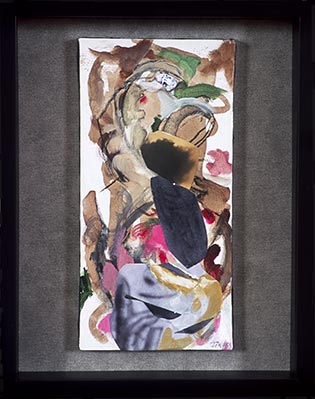Portrait of an Artist — page 2
intricate and needs to be scaled down. Even though I use realistic imagery, I don't consider myself a realist at all. The imagery helps provide a reference point. It helps the viewer to focus on something and move around the 'page' on the canvas. It's a way into the painting. The frames also help in this way. I work with a framer who understands my work, and I work with him on framing each new series."
Motherwell reveals that she didn't start painting until she attended Bard College in the early 1970s. "They had a wonderful art department.," she says. "All the artists lived in New York City and showed there. I really started to understand why dad and Helen were doing what they were doing." Here, Motherwell refers to her father and stepmother, Robert Motherwell and Helen Frankenthaler, two of the canonical figures of 20th century art. "My father never encouraged me to do it," she continues. "He thought, like being an actor, it was a hard life. I don't think either of them thought of me and my sister as artists—that's what they did." Motherwell grew up with her mother and summered in Provincetown in the East End home of her father. "We always had abstractions hanging on the wall," she recalls.
"What was interesting was that when my sister and I were growing up, instead of coloring books, my parents would say, 'Make a poem and draw a picture to it,'" Motherwell continues. "They framed the really good ones, so it gave me a sense of validation to have it framed like their own work. When I was painting in the 1970s, my work was totally abstract. I understood it and could 'read' it well. I think I could tell what was a good abstract painting and what was not from growing up around it. After dad and Helen would hang a show in a museum or gallery they would say, 'Which one is your favorite?' So, I developed an 'eye' at an early age."
During the early '70s, Motherwell moved to New York where she had a loft in Soho, prior to the booming art years that saw the formerly quiet Cast Iron District transformed into a haven of galleries, restaurants and stratospheric property values. "Back then it only had a couple of galleries, and a couple of bars where everyone went to decide which galleries to go to that evening," she recalls. "I lived there for 15 years, married and had a child. I stopped painting for many years and thought I would never go back to it. I was having difficulty in figuring out my identity. I needed to figure out who I was. Was I painting simply because dad and Helen did it? When I stopped, I was convinced it was something I wasn't going to go back to. I thought my role was having a home and being a wife and mother...

"Rosetta: Japanese Daydream" collage
all those things I didn't have growing up." And here the artist pauses, and with a wry sidelong look adds, "Big mistake. You can't change who you are. I guess I had my mid-life crisis early.
"I had a friend who had also stopped painting for many years," Motherwell continues. "He was raising a family and supporting a family with a real job. After many years he started painting again. At that time I began to take postcards and rip them up and glue them together again. I'd hang them on the wall or send them off as gifts. My friend said to me, 'Have fun with it!' I thought, 'Fun?' It was like a light bulb going off. I had never thought of having fun with my work. I needed permission to make mistakes with my work and the idea of having fun gave me this." Motherwell states that she took up painting again five years ago. "The surrealists fascinated me at that time," she says. "I was working at a museum in Connecticut [the Bruce Museum of Science and Arts in Greenwich] teaching programs. There was a terrific surrealist show. It was very freeing, the feeling of not having to 'perform' the way my father and Helen had to."
Motherwell has shown in solo exhibits at the Hunneman Art Gallery, the NoCa All Arts Open Studios at Charles & Associates, and the public library, all in Cambridge. Locally, she has exhibited in two-person shows at the Lyman-Eyer, Boathouse and Provincetown Group Galleries and numerous group exhibitions in Boston, Provincetown and Cambridge. Her work was awarded "Best in Show" at the Annual Open Juried Photography Show at the

Recent Comments